The leader of the destroyers of the Black Sea Fleet "TASHKENT"
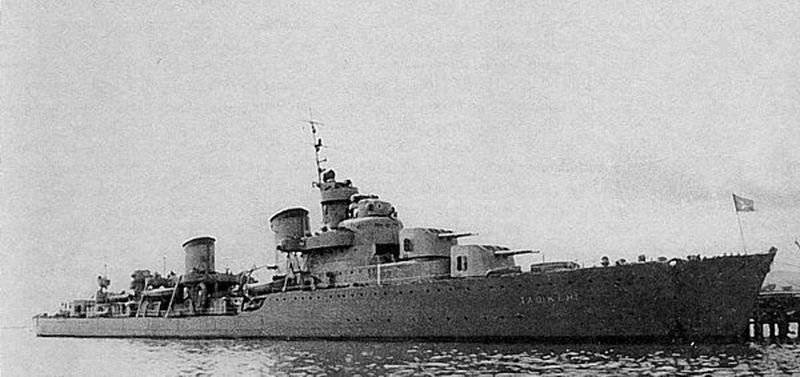
Any ship has its own destiny - one is destined to be a simple worker and quietly go down, another has a difficult, unbelievable, heroic and short existence. A lot of ships can be attributed to the latter, but not everyone can become a legend during his lifetime. That is what he was - the legend of the Black Sea - the leader of "Tashkent". He existed as a warship for just one year, but this year would have been enough for another ship for several of its “lives”. It was his selfless example in the early years of World War II that laid the spirit of future Great Victory over the enemy in the souls of Soviet people. During its short military service to the Motherland "Tashkent":
- 27 passed 000 miles;
- participated in the convoy 17 of Soviet transport vessels;
- delivered to a safe place about 20 000 people;
- transported more than 2500 tons of cargo;
- destroyed 9 and shot down the enemy's 4 aircraft;
- launched a German torpedo boat to the bottom;
- destroyed 6 coastal batteries;
- carried out about 100 fire strikes on the coastal fortifications of the enemy;
- reduced the enemy's manpower by a significant amount.
The rapid movement of the enemy ground forces through the territory of the Soviet Union and the absence of surface forces in the Black Sea region forced the Black Sea Fleet to solve not the combat tasks of destroying the enemy, but the tasks of supplying the Soviet ground forces with weapons, ammunition and food, the tasks of evacuating civilians and troops that fell in the environment. In addition, surface ships began to perform the functions of naval mobile artillery batteries, which helped to reflect the rapid advance of the German troops on the land direction.
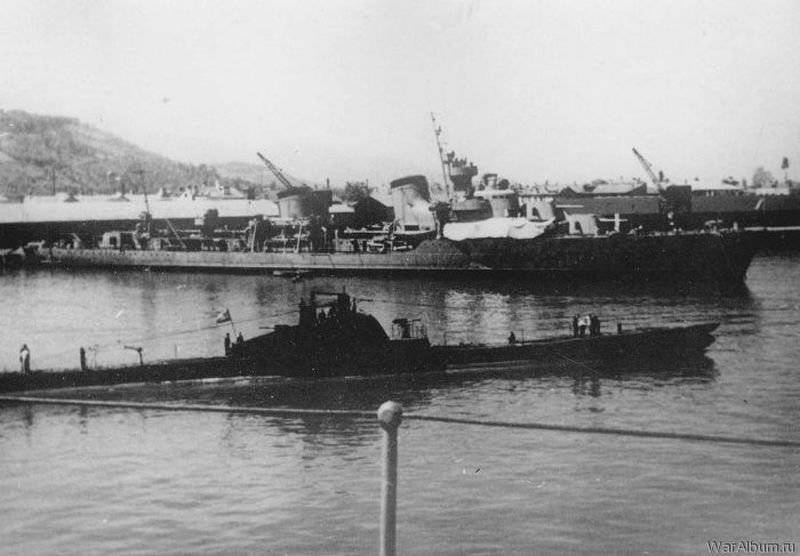
Here is one of the examples of accomplishing the assigned tasks of the “Tashkent” LE - the leader of the destroyers “Tashkent”, 29.08.1941, received the task of suppressing the 155-mm 4-guns of an enemy battery holding approaches to the port of Odessa at gunpoint. The ship at that time was constantly on full alert, and after receiving the task immediately went to its implementation. During the 2-x hour battle, "Tashkent" used X-NUMX high-explosive ammunition and silenced enemy weapons forever. After the battle, Rear Admiral D. Vdovichenko, who was the commander of the support ships detachment, who was present on the ship, thanked the leader and sailors of the leader for their skillful actions during the battle. At the entrance to the port of Odessa, he ordered to transmit to the other ships the signal "Learn to shoot and behave under fire from the sailors of LE Tashkent."
In carrying out the following mission to bombard the coastal fortifications of the enemy, the LE “Tashkent” falls under the attack of enemy bombers. There was practically nothing to oppose with them - naval 37-mm anti-aircraft guns could not reach enemy aircraft at a height of kilometer 4. “Tashkent” in the course of the attack receives serious damage, but still continues to perform maneuvers and evade air attacks, while conducting a dense barrage. Later it turned out that the ship needed urgent repairs, and he and his escort went to the docks of Sevastopol. Already at the factory docks, it turned out that the ship needed 5-month repairs - the propellers and the ship's keel were badly damaged. But the difficult wartime pushed people to look for a way out of seemingly hopeless situations. The engineer of the marine plant offered to carry out repairs right at the dock, putting the ship stern on the jacks. This incredible offer reduced repair time by at least three times.
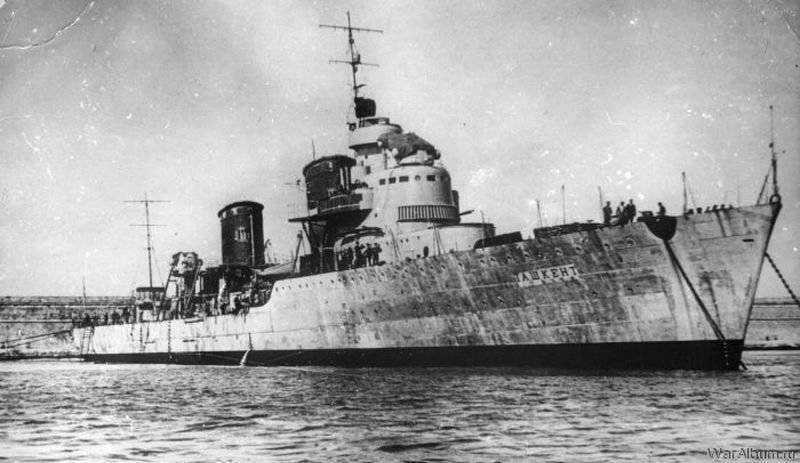
After some discussion, the shipbuilders and the crew accept this proposal. The ship repair works were in full swing both day and night, and people managed to do the impossible - after 1.5 of the month, the ship saw the sea again. At the docks, a 76-mm twin-mounted 39-K gun mounted on the stern of the Tashkent was removed from the unfinished ship Ognevoy. The air defense of the ship improved markedly, now the leader of the destroyers could withstand enemy aircraft operating at altitudes up to 6 kilometers.
November 1941 of the year. PE "Tashkent" takes part in the convoy of ships (icebreaker and three tankers) to the Bosphorus, which went to the Far East. The convoy was held in severe weather conditions during 3-x days - constant snow / rain, at sea 10-ty ball storm. Roll ships sometimes reached the mark 40 degrees. Still, the ships fulfilled their task and brought the transport ships to the Bosphorus.
December 1941 The besieged Sevastopol demanded all possible help, and the LE “Tashkent” began to fulfill the task of delivering the necessary goods to the defenders of the city. "Blue Cruiser" - that is what the soldiers of the Soviet Army called it during World War II. He forever remained in the memory as a naval assistant and defender, always in a hurry to help. He delivered to the besieged Sevastopol marines, reinforcements, weapons and ammunition, food and fuel. Saved transport ships and people from sunken ships. "Tashkent", which had formidable weapons and a large displacement, during the war years, like no other ship, was suitable for such tasks. Speed and maneuverability, protection from the enemy aviation, a large power reserve - this is not all the best qualities of a destroyer leader. Upon arrival in Sevastopol, the ship always left more than half of its fuel reserves besieged. The capacity of the delivered cargo is amazing - for example, in one of the raids, the ship was able to additionally accept 30 railway wagons of ammunition, which were placed in residential / non-residential premises.
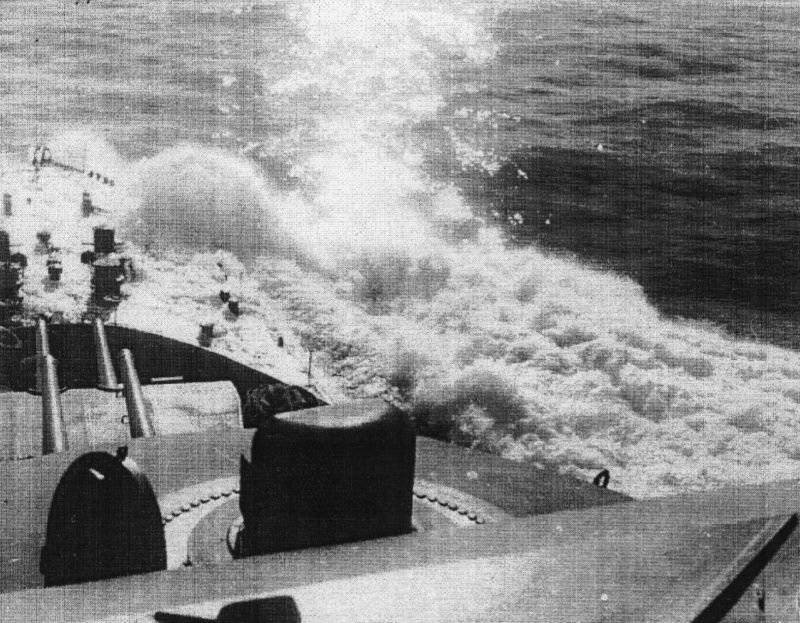
With each raid it became harder and harder to break through to Sevastopol. Each subsequent raid to the besieged city turned into a deadly race, where the "prize" was the life of the defenders of the city. The fate of "Tashkent" depended on the inhuman efforts exerted by each member of the crew. Here is an example of real valor, courage and well-coordinated actions of the LE Tashkent team - 27.06.1942 of the year; when the ship returned after the raid to Novorossiysk, it was attacked by enemy bombers with 86. An unequal battle lasted more than 4 hours, during which the German pilots dropped more than 330 bombs on the ship, and only due to the complete dedication and coherence of each crew member who had an unequal battle with anti-aircraft guns, they carried out constant maneuvers, put out fires and repaired the ship in battle, managed to avoid direct bomb hits on the ship. The leader of the destroyers was badly hurt by indirect hits, but still survived until the arrival of help. On board the ship were 2.3 thousands of evacuees of Sevastopol and valuable cargo. The ship delivered the rescued people and cargoes to the ships that came to help, and he himself reached the ship and got into Tsemessky bay.
For the heroism shown, all the crew members of the LE "Tashkent" were awarded government medals, and the ship's command was awarded the Order of Lenin. The commander of the Caucasian front, S. Budenny, arrived on the ship 1.07.1942 of the year, told the crew that the entire Soviet Union was proud of them and promised to petition the commander-in-chief for the assignment of the ship to the “Guards” rank.
However, the ship did not have time to raise the Guards flag. At noon, 2.07.1942, the ship was attacked right at the base, suddenly appeared by enemy's 30 aircraft. Immediately having received two direct hits, "Tashkent" lay down on the ground. In this raid, enemy aircraft killed 76 crew members, the same number were injured. After the airstrike, the ship was inspected and declared incapacitated due to significant damage. All the surviving equipment is removed from it, as well as the 76-mm anti-aircraft gun mount, which is returned to the fire-fighting “Firing” one. "Tashkent" remained lying at the pier until the liberation of Novorossiysk in 1944. Attempts were made to restore the ship, but this is considered impractical because of the received heavy damage. The ship in tow was brought to Nikolaev, where after the war he was allowed to go to metal.
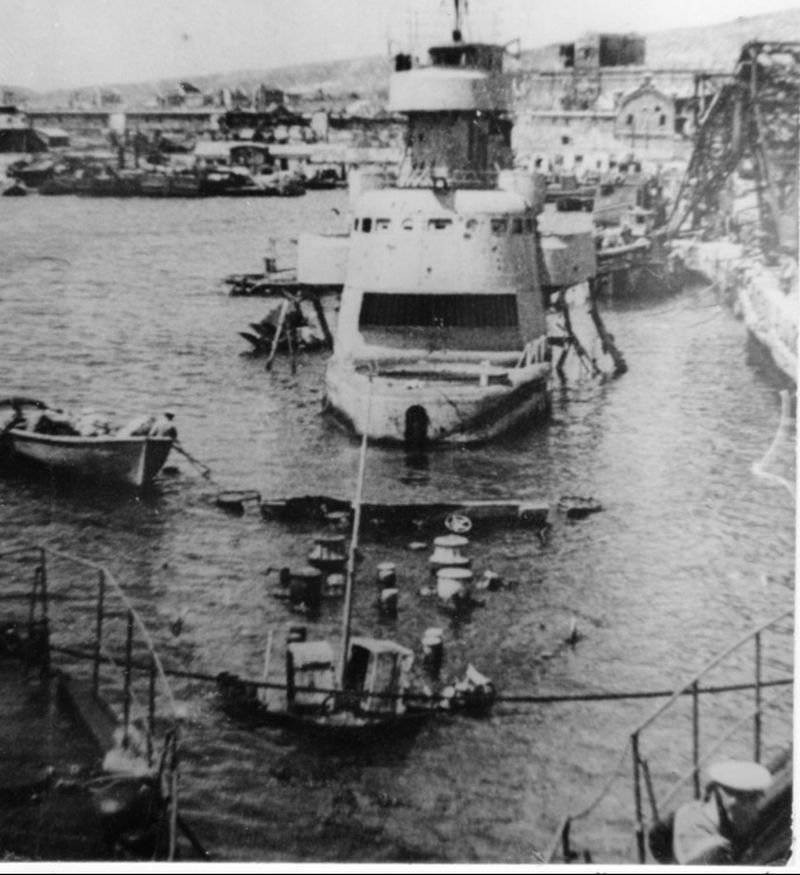
The leader of the destroyers "Tashkent"
The super destroyer or destroyer leader was designed according to the 1933 mission of the year. The maximum speed is up to the 42.5 knot, the range of the 5 is thousands of miles with the 20 knots. For the creation of such a ship is taken the Italian firm "OTO". The ship should have been equipped in an Italian shipyard, and weapons should be installed in the USSR. The development of the ship was uneven: the calm, the crazy race. The new ship of the superehminder type is called "Tashkent". However, the ship was built fairly quickly - they laid the 11.01.1937 of the year, launched the 28.12.1937 of the year.
At the beginning of 1938, the running tests of the new ship begin. During the six hours of travel, the average speed of the 43.5 node, however, the armament was not installed on the ship. To get the maximum speed on the ship, they installed machines that delivered more than 100 000 hp total power, which is much more than the modern cruisers at that time.
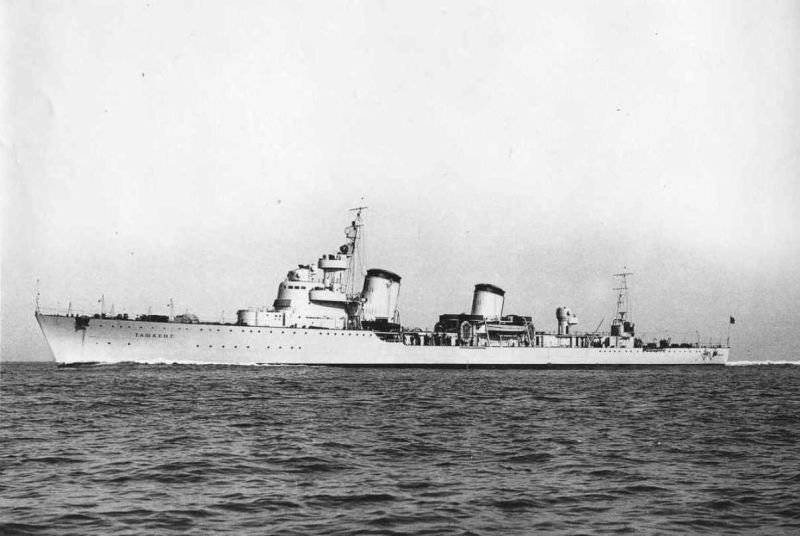
Finally completed the LE "Tashkent" by 1939. 18.04.1939/XNUMX/XNUMX it raised the flag of the naval fleet USSR, and the ship headed for the Black Sea. He arrived in Nikolaev, he was temporarily delivered single 130-mm B-13 guns. Finally, they completed the commissioning of the destroyer leader “Tashkent” in June of the 41st year, a few days before the outbreak of World War II. B-2LM gun turret installations were installed on the ship, which proved to be good during the Second World War and were still used for a long time on the ships of the USSR Navy. The guns were completely covered by 8-mm armor plates, and had a rate of fire of up to 12 rounds per minute. Shooting could be carried out from guns in any weather, with any disturbance of the sea and the speed of the ship. In addition to the main caliber, Tashkent received three 3-pipe torpedo tubes and mine laying rails.
Not bypassed by the "blue cruiser". Due to the predominance of offensive weapons on board, defensive weapons were developed very poorly - 6 semi-automatic anti-aircraft guns of 45-mm caliber were installed on the same bridge. However, in the summer of 1941, the guns replaced the 37-mm anti-aircraft guns. But until the twin 76-mm installation appeared on board, they were still not enough to conduct the air defense of the ship. On the ship, a closed-type command post was installed, which was quite new for surface ships. It allowed the ship to be controlled in any weather, but in the fighting there was a serious lack of closed cabin - the inability to continuously monitor the enemy’s attacking aircraft to carry out evasive maneuvers from attacking vehicles or dropped bombs.
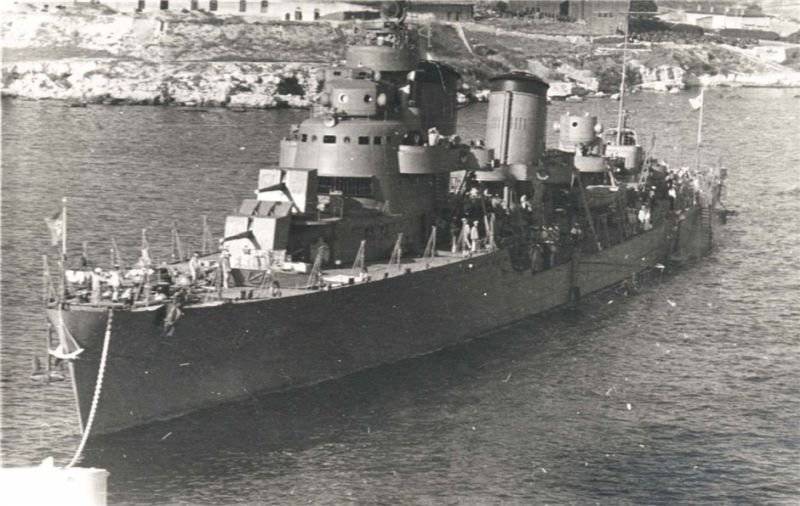
On the basis of LE “Tashkent” there were attempts to build similar ships. However, the LE type "Kiev" on the project began to have a smaller displacement and a smaller supply of fuel with the ensuing consequences. True, it is worth noting the strengthening of protective weapons - they installed a sufficient amount of anti-aircraft weapons. But the ships before World War II did not have time to finish building, and after the war no one finished building the ships. Another continuation of the "blue cruiser" were the Italian ships, which were assembled at the same shipyards using the documentation and experience gained during the construction of the Soviet "Tashkent". The lead ship of the Italian series received the name "Attilio Regolo". The main innovation in the construction was the installation of an additional tower of the main caliber in the stern of the ship. But the Italians could not provide them with decent armor protection, and the ships were very close in size to the cruisers.
Key Features:
- The official date of commissioning - 22.10.1940 year;
- draft / standard / test displacement - 3.2 / 2.9 / 3.4 thousand tons;
- length max / waterline - 139.8 / 133 meter;
- width -13.7 meter;
- draft 4 meter;
- Powerplant: 2 MAL Parsons, each for 51 thousand hp, gear reducer, 4-e Yarrow boiler;
- travel speed - node 42.5;
- fuel - 1170 tons;
- ship crew - 250 people;
Armament:
- The main caliber 130 mm - 3X2 B-2LM, consisting of 6-t guns B-13;
- OMS from the company “Galileo” - the main command and distance measuring post with 2-me 4-x-meter range finders, a spare post with 4-x meter-range range finder;
- 3X3 TA caliber 533 mm;
- 6 DShK caliber 12.7 mm;
- 6 anti-aircraft guns caliber 37 mm;
- 2 bombs, min stock to 110 units;
- 1X2 anti-aircraft gunset 39K caliber 76 mm;
Information sources:
http://hobbyport.ru/ships/tashkent.htm
http://flot.sevastopol.info/ship/lider/tashkent.htm
http://navsource.narod.ru/photos/03/270/index.html
Information